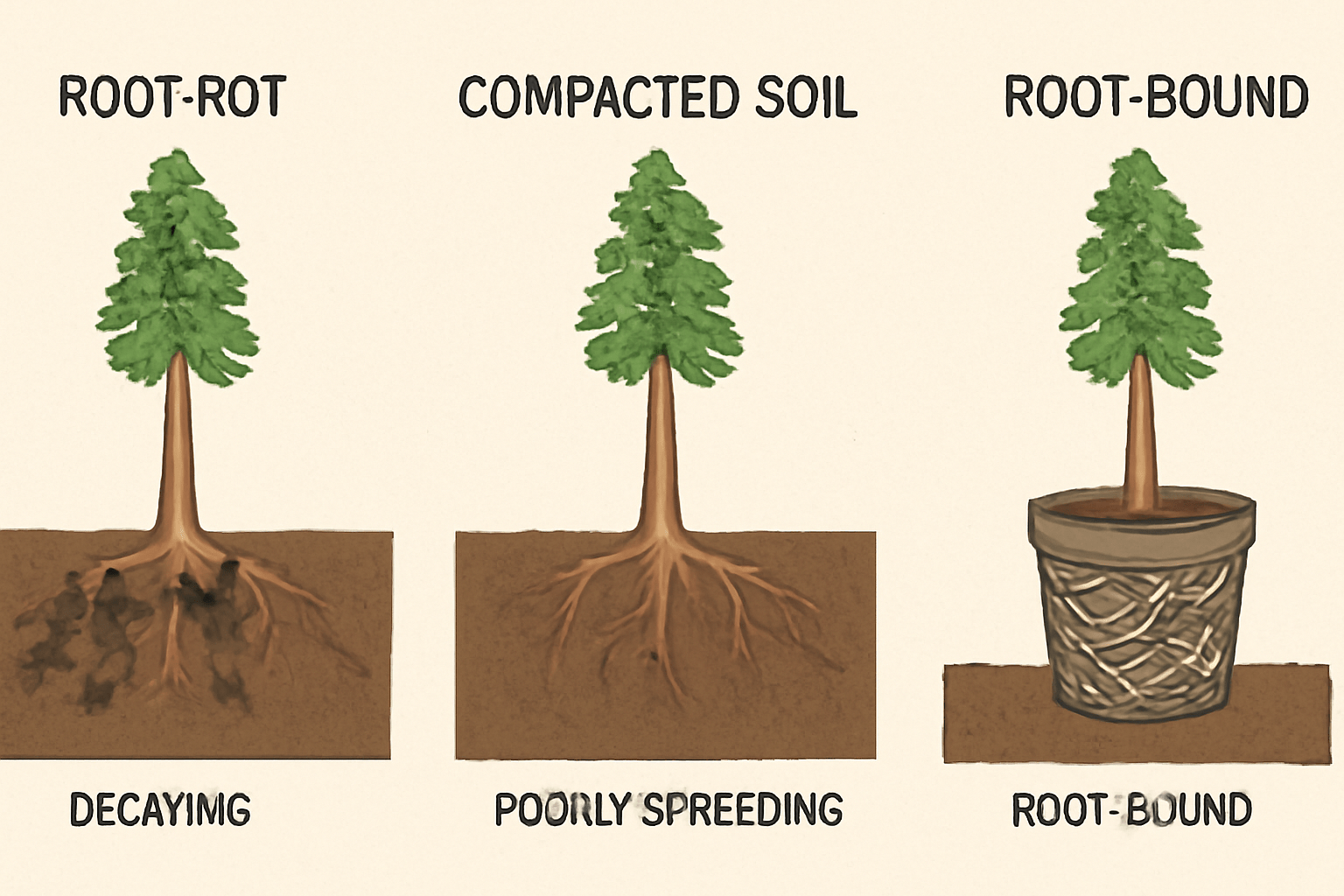
Sequoia Tree Roots Diagram: Understanding Root Structure for Better Growth and Care
Did you know that the roots of a Sequoia tree play a crucial role in its towering growth and long lifespan? 
In this article, we’ll dive into the Sequoia tree roots diagram, breaking down how their roots grow, spread, and anchor the tree. By understanding the root structure, you’ll be better equipped to provide the right care, avoid common pitfalls, and foster a thriving tree. Keep reading to unlock the secrets of these giant roots and improve your tree’s growth!
Table of Contents
ToggleUnderstanding Sequoia Tree Roots 
Sequoia trees are some of the tallest and oldest living organisms on Earth, and understanding their root structure is key to ensuring their health and growth. While these mighty trees stand tall above the forest floor, their roots are equally impressive in their vast network below the ground.
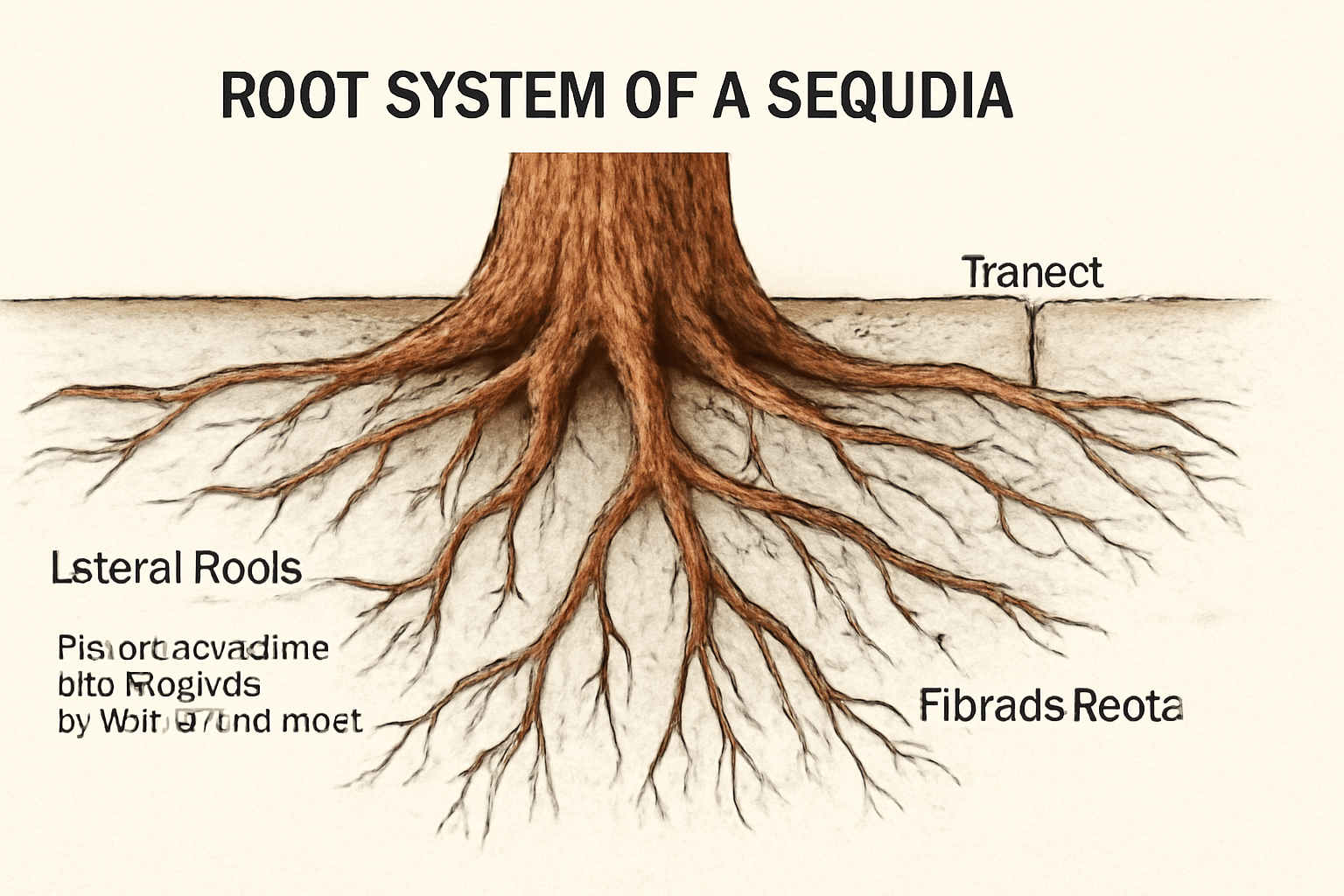
Root System Overview 
The root system of a Sequoia tree is wide and shallow, spreading out as much as 30-40 feet from the trunk. This horizontal growth allows the tree to absorb water and nutrients efficiently from a large area, especially in forests where water is unevenly distributed.
The roots also anchor the tree securely, preventing it from toppling in strong winds or heavy storms. Despite their size, Sequoia roots are not particularly deep (usually no more than 10-12 feet), which helps them thrive in environments where deep roots might not be practical.
Importance of Root Health 
Healthy roots are essential for Sequoia trees to thrive. The roots absorb moisture, deliver nutrients, and provide structural stability to the tree. Without a robust root system, the tree cannot grow to its full potential.
To ensure optimal root health, Sequoia trees benefit from well-draining soil. If the soil is too compacted or waterlogged, it can suffocate the roots, causing disease and stunted growth. It’s important to maintain a good balance between moisture and air circulation in the soil surrounding the tree.
Root Care Tips 
- Watering: Sequoias prefer deep, infrequent watering to mimic natural rainfall. Overwatering can cause root rot, so it’s crucial to allow the soil to dry out between waterings.
- Mulching: Adding a layer of organic mulch around the base of the tree can help maintain moisture and protect the roots from temperature extremes. Just make sure the mulch is not piled directly against the trunk.
- Soil Health: Regularly check the soil for compaction. If the soil is too dense, consider aerating it to allow roots to spread more freely.
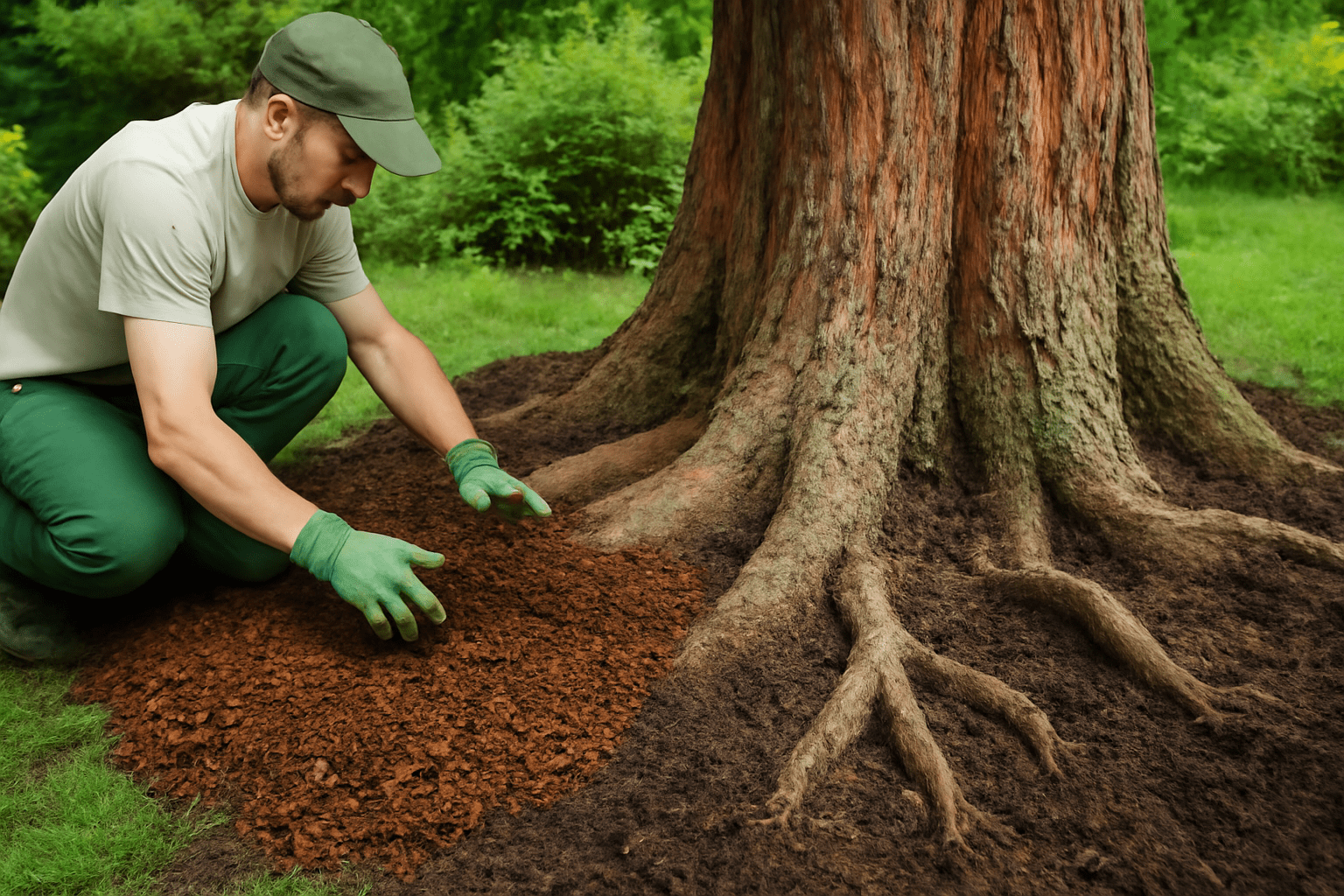
By understanding and caring for the root system, you can ensure your Sequoia tree stays healthy, grows strong, and reaches its impressive potential over the years 
How Sequoia Tree Roots Grow 
Understanding how Sequoia tree roots grow is essential for ensuring their health and vitality. Sequoias, one of the largest and most impressive tree species, have unique root systems that play a crucial role in their survival and growth. Here’s a closer look at their root structure and how it contributes to their extraordinary height and strength.
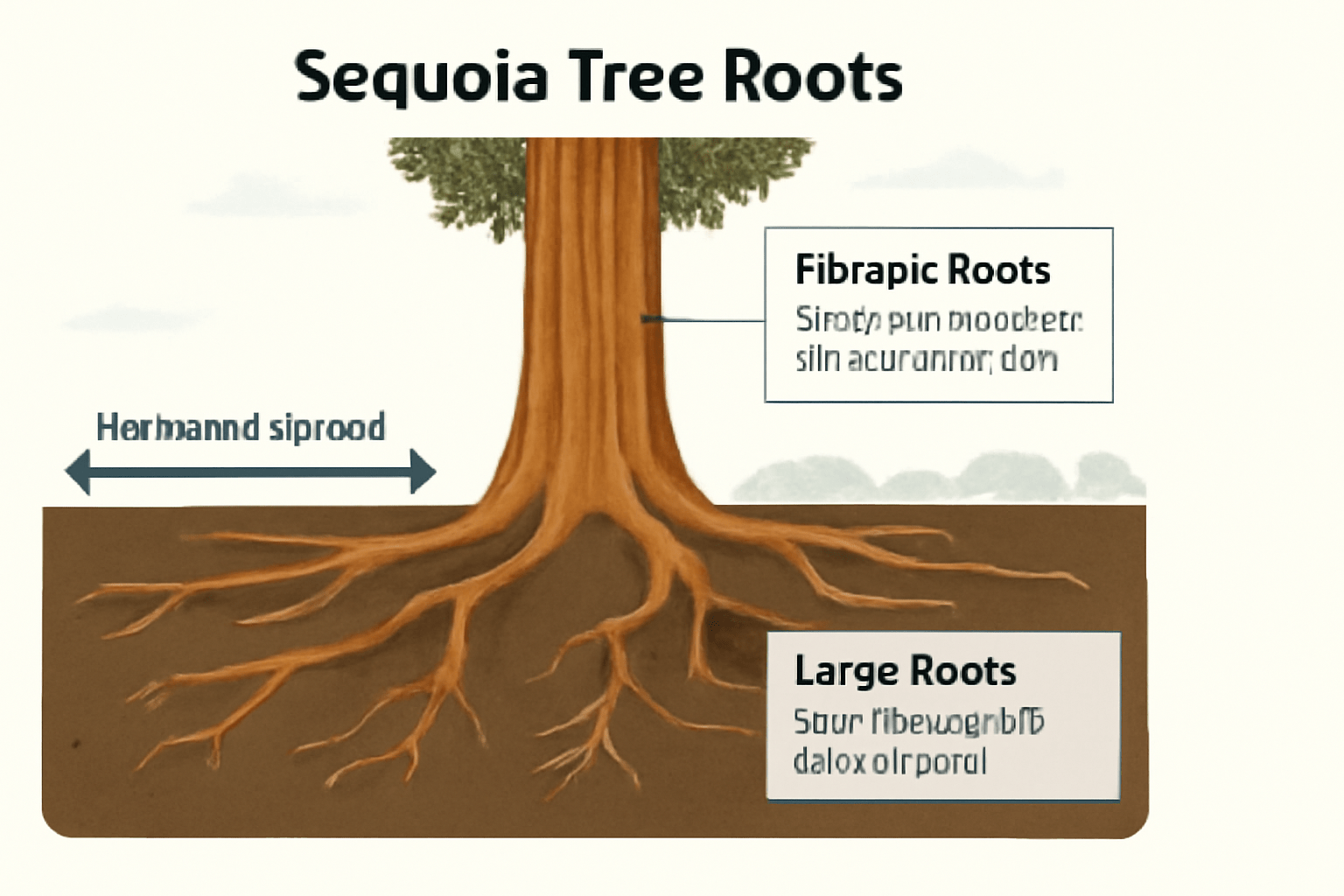
Shallow Yet Extensive Roots
Sequoia tree roots are generally shallow, extending horizontally more than they go deep. In their natural habitat, these roots spread out to about 30-40 feet (9-12 meters) from the tree trunk, forming an expansive network that can support the massive tree structure. The shallow roots help the tree absorb water and nutrients from the topsoil, especially in regions with irregular rainfall.
The Importance of Fibrous Roots
Sequoias rely on a dense network of fine, fibrous roots near the surface. These fine roots are critical for the absorption of nutrients, including nitrogen, potassium, and phosphorus, which are essential for growth. The fibrous root system ensures that the tree can capture a high volume of nutrients, even in poor soil conditions.
Root Adaptation for Stability
While the roots may not penetrate deeply, Sequoias adapt by forming a wide and interlocking root system. This helps provide stability and prevents the tree from toppling over in strong winds. The interconnection between roots allows them to share resources, promoting overall tree health and strength.
Importance of Companion Roots
Sequoias often benefit from symbiotic relationships with other plants. Their roots can intertwine with those of neighboring plants, forming a mutual support system. This interaction improves soil aeration and increases the efficiency of water absorption, promoting better growth for all involved.
Why Root Care Matters
For healthy Sequoias, it’s important to understand their root needs. Avoid compacting the soil around the base of the tree, as it can restrict root expansion and water flow. Additionally, ensure the soil around the tree is well-draining, as poor drainage can lead to root rot.
By understanding how Sequoia tree roots grow, you’ll be better equipped to nurture these majestic giants. Whether you’re planting a Sequoia or caring for an existing one, paying attention to root health will ensure your tree thrives for years to come!
Visualizing Sequoia Tree Roots – Diagram Breakdown 
Understanding the root structure of a Sequoia tree is essential for nurturing its growth and ensuring its health. Sequoia trees, known for their towering heights, have a unique root system that supports their massive size and longevity. In this section, we’ll break down the diagram of Sequoia tree roots and explain each part so you can visualize how these roots function to support the tree.
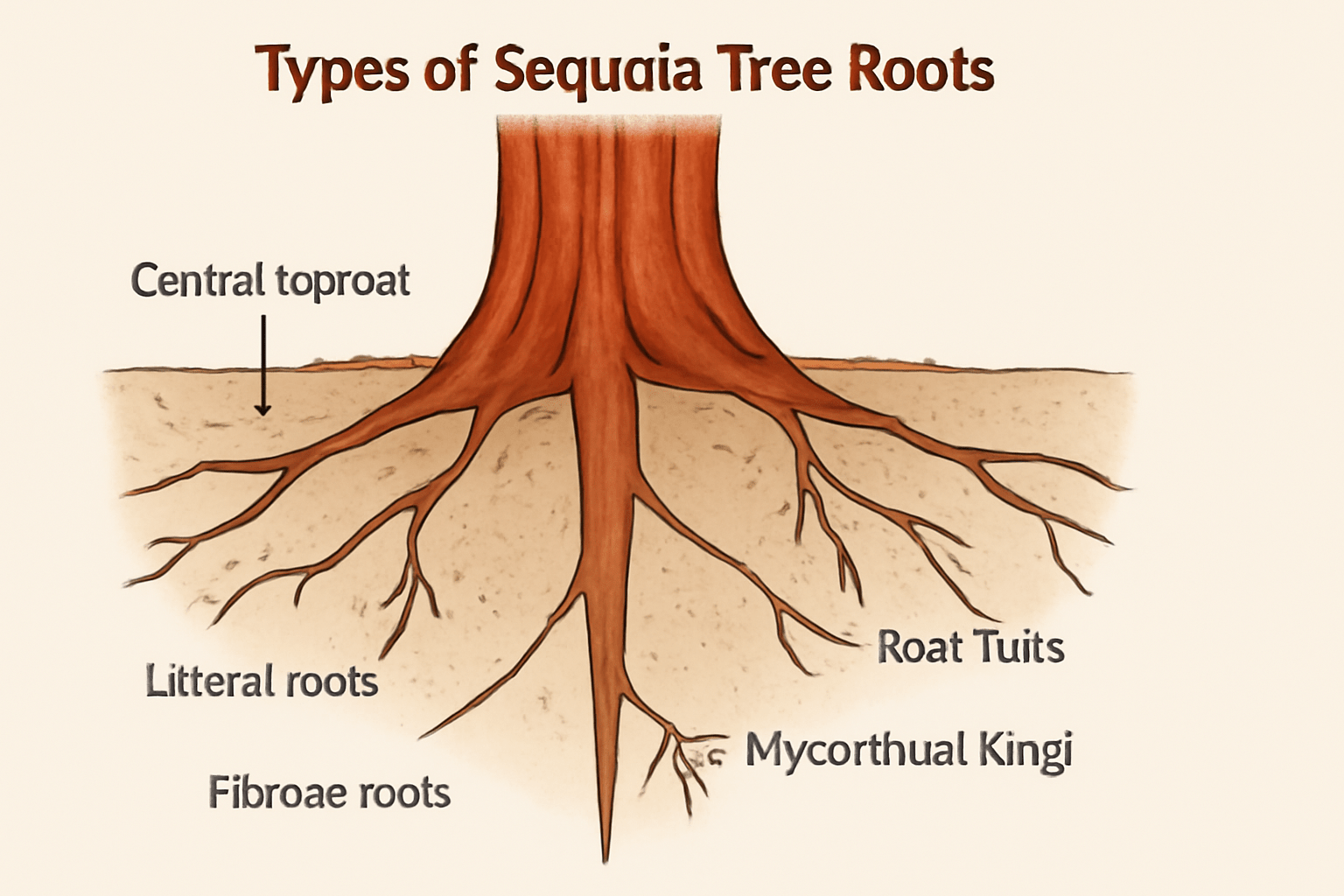
1. Taproot: The Foundation 
The taproot is the central root that grows deep into the soil, acting as the tree’s anchor. It helps the Sequoia access deep water sources and provides stability against strong winds. This root typically grows straight down and can reach impressive depths, offering long-term support to the towering tree.
2. Lateral Roots: Spreading Outwards 
Extending from the taproot, lateral roots spread out horizontally near the surface of the soil. These roots are crucial for absorbing nutrients and water from the surrounding area. They also help prevent soil erosion by holding the soil in place. Sequoias have an expansive lateral root system, enabling them to access resources across a large area.
3. Fibrous Roots: The Nutrient Absorbers 
Fibrous roots are small, thin roots that emerge from the lateral roots. These roots are responsible for absorbing most of the nutrients and water needed by the tree. The network of fibrous roots forms a dense mat near the surface, helping the tree take advantage of the soil’s nutrient-rich upper layers.
4. Root Hairs: The Microscopic Helpers 
Root hairs, tiny extensions of the fibrous roots, play a vital role in nutrient absorption. Though they are not always visible to the naked eye, these microscopic structures vastly increase the surface area for nutrient and water intake, making them crucial for the tree’s survival, especially in nutrient-poor soil.
5. Mycorrhizal Fungi: The Symbiotic Partners 
Sequoia roots often form symbiotic relationships with mycorrhizal fungi. These fungi attach to the roots and extend their filaments into the soil, increasing the surface area for nutrient absorption. In exchange, the fungi receive sugars from the tree. This mutually beneficial relationship boosts the Sequoia’s ability to thrive in diverse environments.
By understanding the diagram of Sequoia tree roots, you can better appreciate how these remarkable trees sustain themselves and grow to such impressive heights. A healthy root system is essential for the Sequoia’s growth and longevity, and by recognizing each root’s role, you can apply these insights to promote better care and growth for your own trees.
How Sequoia Roots Impact Tree Growth 
The root system of a Sequoia tree plays a crucial role in its growth and overall health. Understanding how these roots function will help you provide the best care for your tree. Let’s break down the key aspects:
- Anchoring and Stability
Sequoia roots are designed to provide strong anchorage. Their deep taproot and extensive lateral roots allow the tree to withstand heavy winds and challenging weather conditions. This robust foundation is essential for stability, especially in mature trees that can reach incredible heights. - Nutrient and Water Absorption
Sequoia roots are highly efficient at absorbing nutrients and water from the soil. The spread of the roots allows the tree to access a large area of soil, ensuring it gets the necessary resources for healthy growth. Proper watering is essential for promoting root health, ensuring your Sequoia thrives. - Root Depth and Growth
As the Sequoia tree matures, its roots continue to expand both in depth and width. The deep taproot helps the tree reach groundwater in dry conditions, while the shallow lateral roots spread out horizontally to gather surface moisture. This dual rooting system makes Sequoias adaptable to various environmental conditions. - Soil Aeration
The Sequoia root system also helps with soil aeration. As the roots penetrate the ground, they create channels in the soil that allow air to reach other plant roots. This promotes a healthier garden environment for other plants growing nearby, benefiting the overall ecosystem. - Impact of Root Health on Tree Growth
Healthy roots mean a healthier tree. Regular maintenance of the soil and proper watering can prevent root diseases and encourage strong, steady growth. Conversely, poor root health—due to factors like compacted soil or overwatering—can stunt growth and make the tree more susceptible to stress.
By understanding how Sequoia roots function, you can ensure your tree has the best possible foundation for growth. Whether you’re planting a new tree or caring for a mature one, keeping these root dynamics in mind will help you maintain a healthy and thriving Sequoia.
Common Root-Related Issues and How to Avoid Them 
Sequoia trees, with their towering beauty and impressive growth, rely heavily on healthy roots for stability and nourishment. However, like all trees, they can face root-related problems that can stunt their growth or cause other health issues. Here’s how to identify and avoid common root problems:
1. Root Rot 
Root rot occurs when the roots are consistently waterlogged, depriving them of oxygen. Overwatering or poor drainage can lead to this issue, causing the roots to decay and ultimately harming the tree.
How to Avoid It:
- Ensure proper drainage in the soil.
- Water the tree only when the top few inches of soil are dry.
- Avoid using heavy, clay-rich soil that doesn’t drain well.
2. Root Bound Conditions 
Sequoia trees with a root system that becomes too confined or tangled within a pot or small space can struggle to grow properly. This “root bound” condition restricts root development, which limits the tree’s ability to access nutrients and water.
How to Avoid It:
- When planting, provide enough space for roots to grow freely.
- Regularly check for root-bound conditions and repot the tree when necessary.
- Use wide, deep pots for container-grown Sequoias.
3. Compacted Soil 
Soil that is too compacted prevents the roots from spreading out and accessing water and nutrients. This often happens in areas with heavy foot traffic or where the soil has been disturbed.
How to Avoid It:
- Mulch around the base of the tree to keep the soil loose and cool.
- Aerate the soil regularly to ensure proper oxygen flow to the roots.
- Avoid disturbing the soil near the root zone.
4. Root Damage from Tools or Lawn Equipment 
Accidental damage to the roots by shovels, lawnmowers, or other garden tools can create entry points for diseases and pests, weakening the tree.
How to Avoid It:
- Be cautious when using garden tools near the base of the tree.
- Mark the area around the tree’s root zone to avoid accidental damage.
- Use a root protector or barrier if planting in high-traffic areas.
5. Nutrient Deficiencies 
Sometimes, roots struggle to absorb nutrients due to a lack of key minerals in the soil. This can lead to poor growth and yellowing leaves.
How to Avoid It:
- Test the soil regularly to check for nutrient deficiencies.
- Amend the soil with organic compost or a balanced fertilizer.
- Ensure the tree is getting the right amount of sunlight, water, and space.
By understanding and addressing these root-related issues, you can ensure your Sequoia tree grows strong, healthy, and beautifully tall 
Caring for Sequoia Tree Roots 
When it comes to growing and maintaining a healthy Sequoia tree, taking care of the roots is crucial! Healthy roots are the foundation of strong, thriving trees, and understanding how to care for them will ensure your Sequoia grows tall and majestic.
1. Watering the Roots 
Sequoia trees need consistent moisture, especially when they’re young. Water the roots deeply but avoid overwatering. Sequoias are susceptible to root rot if the soil remains too soggy. Aim to water once a week during dry periods, ensuring the water penetrates deep into the soil to reach the root zone.
2. Proper Soil Drainage 
Good drainage is essential for Sequoia roots to thrive. The soil should be well-draining to prevent water from accumulating around the roots. Sandy loam or well-aerated soil is perfect. If your soil is heavy and clay-like, consider adding organic matter or creating raised beds for better root health.
3. Mulching Around the Base 
Adding a layer of mulch around the base of your Sequoia helps retain moisture, regulate soil temperature, and prevent weeds that can compete with your tree for nutrients. Apply a 2-3 inch layer of organic mulch like wood chips or leaves, keeping the mulch a few inches away from the trunk to avoid rot.
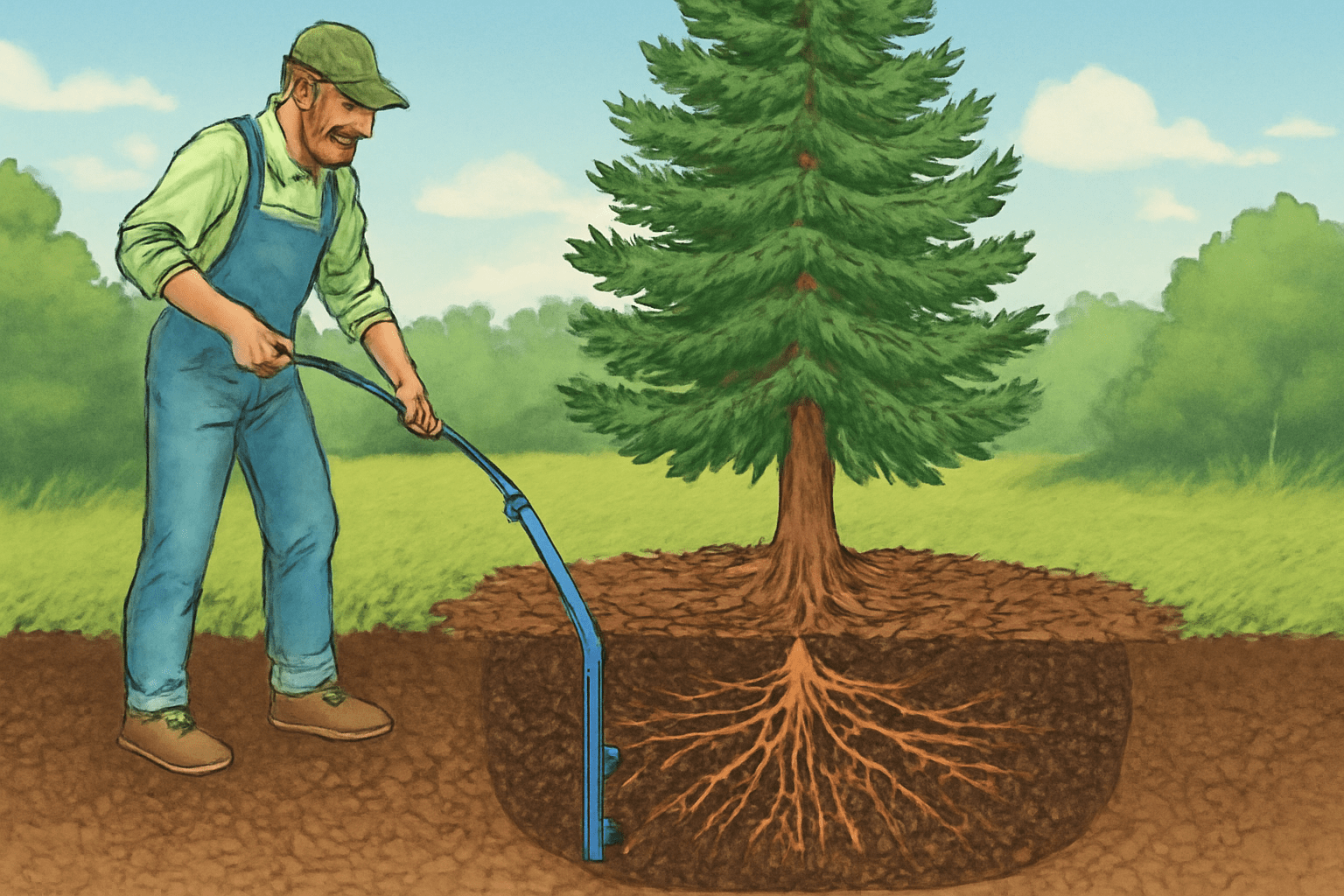
4. Avoid Root Compaction 
Sequoia roots need plenty of room to spread out and breathe. Avoid heavy foot traffic or placing anything heavy near the base of the tree that could compact the soil. If the soil becomes compacted, the roots won’t be able to absorb nutrients and water effectively. Aerating the soil around the tree every year can help maintain root health.
5. Pruning the Roots Carefully 
Although Sequoia trees don’t require regular root pruning, it’s important to trim any damaged or diseased roots during planting or when transplanting. Use sterilized tools to prevent the spread of diseases. If you must prune, do so gently and avoid cutting healthy roots unless absolutely necessary.
6. Protecting from Root Pests 
Like all trees, Sequoia roots can be susceptible to pests like root weevils or root rot fungi. Keep an eye out for signs of damage, such as stunted growth or yellowing leaves. If pests are detected, remove the affected roots and treat with an organic pesticide or fungicide to protect the tree.
By following these simple care tips, you can ensure your Sequoia tree’s roots stay healthy and strong, allowing the tree to grow into the giant it’s destined to be!
Sequoia Tree Root Maintenance Over Time
Maintaining healthy roots is crucial for the long-term success of your Sequoia tree. 
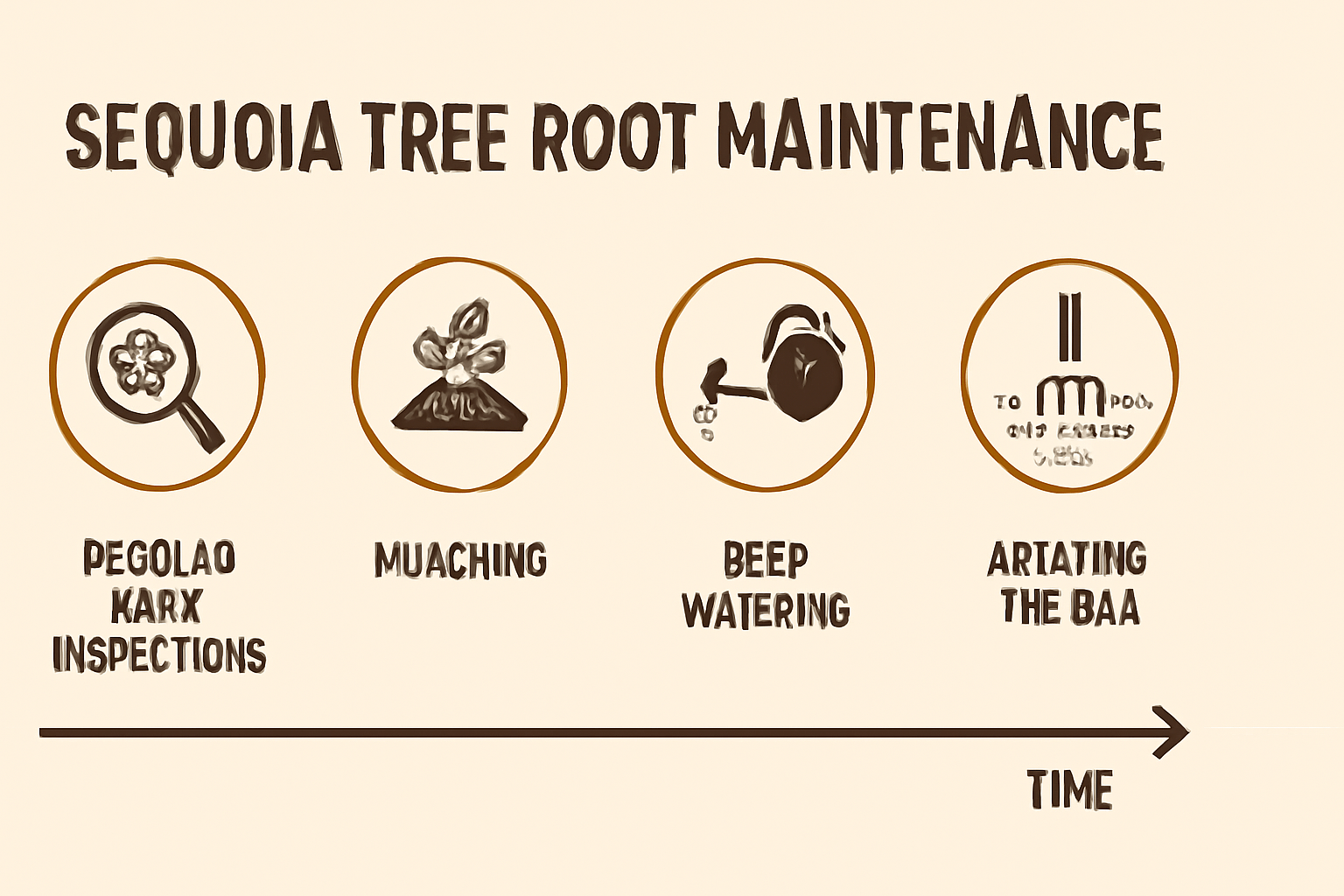
1. Regular Root Inspections
Over time, root health can be affected by soil compaction, disease, and competition from nearby plants. Regularly check the area around the tree’s base. If you notice any signs of root rot (e.g., foul smell, blackened roots), it’s time to take action.
2. Mulch Wisely
Mulching around the base of your Sequoia can help retain moisture and regulate soil temperature. However, avoid piling mulch directly against the trunk as it can encourage fungal growth. Keep mulch about 3-4 inches away from the trunk to maintain airflow around the roots.
3. Proper Watering Techniques
Sequoia trees have deep roots, but they still need consistent watering, especially during dry periods. Water deeply but infrequently, allowing the roots to absorb moisture effectively. 
4. Avoid Root Disturbance
As your Sequoia tree grows, its roots spread outwards. To prevent disturbing the root system, avoid planting other large plants or trees too close. This reduces root competition for nutrients and ensures your Sequoia has enough space to grow.
5. Prune Root Suckers
As Sequoia trees age, they may send up root suckers (young shoots growing from the roots). While these are not necessarily harmful, they can steal nutrients from the main tree. Regularly prune any suckers you see to keep the root system focused on sustaining the primary tree.
6. Fertilization
Fertilizing around the root zone can promote healthy growth, but be cautious not to overdo it. Use a slow-release fertilizer to avoid burning the roots, and apply it in early spring when the tree is beginning its growing season.
By staying on top of these root maintenance practices, you’ll help your Sequoia tree establish a strong foundation, ensuring it thrives for many years to come!
Conclusion
In conclusion, the root system of a Sequoia tree is essential to its growth, stability, and longevity. By understanding the Sequoia tree roots diagram and how each part of the root system works, you can ensure that your tree receives the best care possible. From providing ample space for roots to grow, to maintaining healthy soil conditions and proper watering, each step you take will contribute to the strength and vitality of your Sequoia tree.
Remember, healthy roots are the foundation of a thriving tree. With the insights shared in this guide, you can confidently nurture your Sequoia tree, ensuring it grows tall and strong for years to come. So, whether you’re planting a Sequoia or caring for an existing one, taking care of its roots will always be the first step toward success. Happy planting!
Frequently Asked Questions(FAQ)
How deep do Sequoia tree roots grow?
Sequoia tree roots can grow up to 10 feet deep, with the taproot being the deepest part. However, the majority of the roots spread out horizontally in the top 3-6 feet of soil, allowing the tree to access water and nutrients efficiently.
How far do Sequoia tree roots spread?
The roots of a Sequoia tree can extend up to 100 feet or more horizontally, depending on soil conditions. This wide spread helps the tree absorb enough water and nutrients to support its massive size.
What is the role of the taproot in Sequoia trees?
The taproot is the primary vertical root that provides stability and anchors the tree to the ground. It helps the Sequoia tree resist toppling in strong winds and droughts, while also reaching deeper water sources.
Can Sequoia trees grow in compacted soil?
No, Sequoia trees require well-draining soil for healthy root development. Compacted soil limits the spread and growth of their roots, preventing them from accessing necessary nutrients and water.
What is the best soil type for Sequoia trees?
Sequoia trees thrive in slightly acidic to neutral, well-draining soil. Sandy loam or soils enriched with organic matter are ideal for root expansion and overall health.
How do I care for Sequoia tree roots?
To care for Sequoia tree roots, ensure the soil remains well-drained and not compacted. Water deeply and consistently, especially during dry periods, and add mulch to protect the roots and retain moisture.
What are the signs that Sequoia tree roots are unhealthy?
Signs of unhealthy roots include yellowing leaves, wilting, and stunted growth. If the roots are too wet or compacted, they may rot, which can severely affect the tree’s overall health.
How can I improve the root growth of my Sequoia tree?
To promote healthy root growth, plant your Sequoia in a spacious area with plenty of room for the roots to expand. Improve the soil’s texture with organic compost and ensure consistent, deep watering, especially during the early stages of growth.








